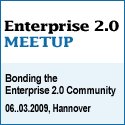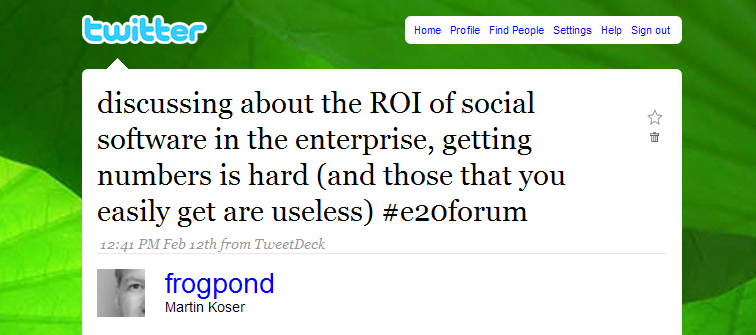Some days ago I posted David Terrars keynote slides about community building in the Enterprise at the enterprise 2 open blog.
Being the community manager for the E2.0 SUMMIT I am perfectly fine when you click on through and continue there, all the while my posts are spliced into the regular frogpond feed too.
Whatever, I wanted to expand into something David mentioned in his talk – a video of Cisco’s John Chambers and see where it gets me. Interesting hooks make me follow trails (plus I have observed Cisco moves and Chamber’s video already before, see below for some pointers to past posts and there was this neat article about Cisco in Fast Company too) so the tagline “shifting from command and control management to collaboration and teamwork” made me investigate.
Let’s start with the Harvard Business School video of John Chambers David mentions (seen also at Oliver Marks):
[…] he envisions a Web 2.0 premised on collaboration and social networking that will similarly transfigure all business life. Since 2001, he’s been positioning Cisco to catch this massive market transition, and indeed, is “betting the company’s future on it.”
[…] Web 2.0 will also bring “effective collaboration,” by which Chambers means network-enabled visual tools, which will make “working together for a common goal truly possible.” Expect much faster business processes and revved up productivity, says Chambers.
Sounds much like an argument for “improving collaborative performance”, heh? Yes, but democratizing decision making by using Enterprise 2.0 technologies (eating dog food and walking the talk, you know …), pursuing a vision of a more innovative and competitive company, of future work styles – that’s the success story and archetypical vision that keeps me and others in the surrounding Enterprise 2.0 consulting space motivated.
See also this video from a presentation and Q&A he carried out at the MIT Sloan School of Management:
Based on Cisco’s own experience in the past several years, organizations will [need to] completely restructure around these new capabilities. Indeed, he offers up his company as a paradigm of this vision. Once a hierarchical, command and control-based organization, Cisco is now much flatter, a company running “off of social networking groups.” Councils with cross-functional responsibilities suggest and take on many more projects (from emerging markets, to video, and smart grid boards); from one to two major ventures per year, to this year’s 26 launches. The next generation company is “built around the visual.” Cisco employees do non-stop teleconferencing with collaborators around the world. The company hosts 2500 such virtual meetings per week. It also employs Webex, Wikis and blogging to move work along.
With this kind of communication and carefully managed process to match, “operations can be turned on a head,” says Chambers. It’s the recipe for market-dominating speed and scale. Chambers is “loading the pipeline” with projects that assume other companies will want what Cisco has and makes. “If we’re right, we’re developing a huge wave of revenue opportunity.” Perhaps this is one reason why he’s “an optimist on global productivity, global economy and our ability to handle the challenges.”
That’s the thing: Enterprise 2.0 can be a way for speed and scale, both depending on and promoting changed decision making processes (“Web 2.0 changing decision making processes within organizations“):
[…] Chambers emphasized that social networks are changing businesses making them less hierarchical and more network oriented.
[…] decision making can be accelerated (and be more distributed, democratized, deconstructed, diversified, …). In fact, the main change effect is not acceleration (but the change effects in brackets …)
Repeat with me: the main change effect is not acceleration – but we may be tempted to measure this first in our efforts to calculate ROIs.
Moreover, with the Cisco focus on video and teleconferencing I am not convinced, see what I blogged about another speech of Chambers in May 2007, noting that
[…] Intel [is] calling for businesses to increase knowledge worker productivity by implementing Web 2.0 social software but also by fostering mashups and virtual conferencing.
[…] I am reserved whether video is really the killer application among the collaboration tools. Requiring synchronous presence of distributed collaborators is both costly and unnecessary most of the time (think more meetings …) whereas tools for virtual distributed collaboration like wikis are a low-cost approach that can be tailored to the actual needs (think more flexibility and serendipidity …).
So my observation that Cisco might not be much of a role model (and that results may vary …), especially when naively imitating Ciscos approaches:
[…] social networking in the enterprise is not “easy”. One reason is that this is not a technology problem (with some kind of tech answer), but a people problem. Supplementing organizational hierarchies and “command and control” decision structures with free-form collaboration and teamwork approaches needs some serious thinking before “kicking-off these projects”, taking into account that this calls for broad implementation approaches, lead and energized by skillful managers, and more …
Anyway, I ended on a very positive note (that now, in 2009, may finally hit it big time):
[when] we employ freeform social software and enterprise 2.0 concepts we can ease implementation, like when we leverage bottom-up mechanisms that are already in place, and allow for the emergence of usage and networking patterns that reflect and support the actual informal networks that exist in the organization anyway.
Social software may enter the corporate world quite naturally in the end …
What do you think? Have we seen a sort of tipping point now that McKinsey has published yet another piece?
 It’s that time of the year again –
It’s that time of the year again – 

![Reblog this post [with Zemanta]](http://img.zemanta.com/reblog_e.png?x-id=03d2fd0e-07fd-4f14-8425-edcadcc6ee99)
